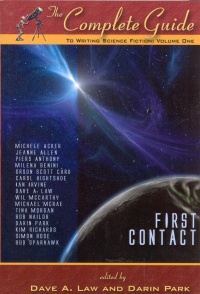| ________________
CM . . .
. Volume XIV Number 15 . . . .March 21, 2008 
 |
The Complete Guide to Writing Science Fiction: Volume One. - First Contact.
Dave A. Law & Darin Park, eds.
Calgary, AB: Dragon Moon Press/Hades Publications, 2007.
311 pp., pbk., $24.95.
ISBN 978-1-896944-39-5.
Subject Headings:
Science fiction-Authorship.
Science fiction.
Grades 8 and up / Ages 13 and up.
Review by Ronald Hore.
*** /4
|
| |
|

excerpt:
As is so often the case, prevention is the best cure: if you intend to write in genre–any genre–you should read just about everything in the genre that you can find, so you will know what’s been done before you and how it’s been done. It’s also a good idea to look at different sources, such as anthologies and bibliographies, and make sure you haven’t missed anything important. Even though SF is not taught systematically in most schools, there is a rich body of theoretical work pertaining to it, and you should not be afraid to make use of it. But in case you missed something, here’s a short list of stories you should not attempt to write unless you have an incredibly new twist on them. There are much longer lists on the Internet, but this is a short overview of the most important ones. We’ll start from storyline and setting cliches, because–particularly in SF–they are often connected.
The Complete Guide to Writing Science Fiction is the first volume of a series on writing science fiction. It is broken down into five parts: Defining, Building, Crafting, Specializing, and Publishing and Beyond, plus Appendixes. The contributors offer their broad range of experience and insights.
Part One, "Defining," covers the following topics as best described by the following excerpts from the chapter titles: A History of Science Fiction, the Definitive Definition of Science Fiction, Science First Fiction Second, and the Many Faces of Science Fiction. These interesting chapters, totaling 35 pages, give a good introduction and provide a broad background to the topic.
Part Two, "Building," covers technology, world building, alien creation, outer space and cliches to beware of. These 81 pages get into more of the detail and technology required when you are looking at creating your science fiction stories.
Part Three, "Crafting," looks at creating characters, ideas and plot, and tightening the manuscript prior to approaching a publisher. These 55 pages cover more of the detail as the story comes together.
Part Four, "Specializing," discusses issues as wide ranging as humour, fan fiction, graphic novels, and writing for younger readers. Even if you have been reading science fiction for several years, you will learn something new within these 37 pages.
Part Five, "Publishing and Beyond," takes the reader to the final part of the writing process. These 53 pages cover the spectrum from the publisher to the life of a writer.
The Appendixes are quite thorough. Appendix A provides brief biographies on the 16 writers who contributed to the book. Appendix B is a list of reference books for general reading as well as those mentioned in the articles in the guide. These are followed by a section of Endnotes and an Index of the contents. There are 32 pages in this section. The final five pages list other science fiction and fantasy titles put out by this publisher.
The Complete Guide to Writing Science Fiction would be of interest to the reader who is thinking about writing in the genre, or simply someone who has an interest in learning more about the history and inner workings of science fiction. The practical information considers presentation, promotion and takes a look at what happens when a writer succeeds and covers everything from the very basics to information for the serious writer. While the technical portions might make younger readers wince, there is enough information to keep the average SF fan interested. Well-written, it is a reference that should appeal to both the student and the budding author.
Recommended.
Ronald Hore, involved with writer’s groups and workshops for several years, retired from the business world in Winnipeg, MB.

To comment
on this title or this review, send mail to cm@umanitoba.ca.
Copyright © the Manitoba Library Association. Reproduction for personal
use is permitted only if this copyright notice is maintained. Any
other reproduction is prohibited without permission.
NEXT REVIEW |
TABLE OF CONTENTS FOR THIS ISSUE
- March 21, 2008.
AUTHORS |
TITLES |
MEDIA REVIEWS |
PROFILES |
BACK ISSUES |
SEARCH |
CMARCHIVE |
HOME |
